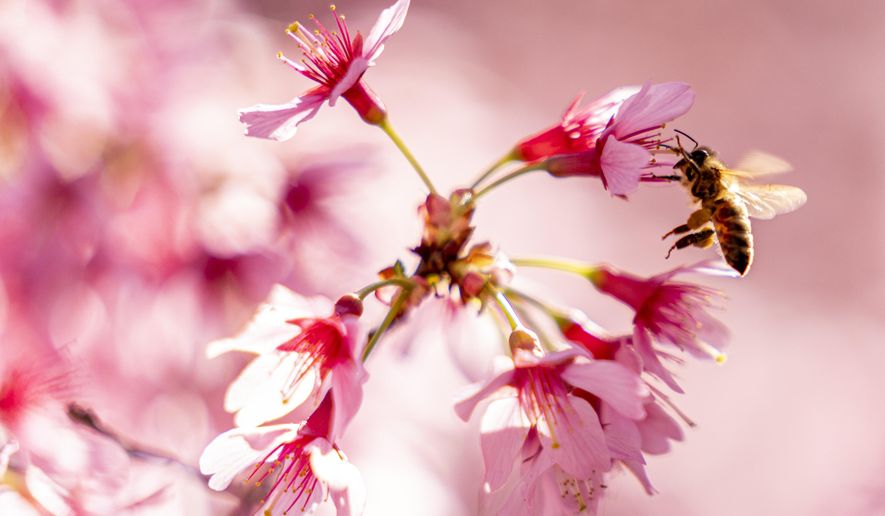A remarkably warm winter has tricked some trees and plants into blooming early, which could doom them if a cold snap hits, horticulturalists and arborists in the D.C. area say.
Officials at the National Arboretum say they already have lost a third of their camellia collection to the vagaries of a snowless winter that brought high temperatures of near 80 degrees on Thursday.
“You could say our winter flowering camellias took a hit,” said Richard T. Olsen, director of the 446-acre botanical research center in Northeast Washington. “They tend to flower during warm spells through the fall into winter, but the coldest spell last month wiped out flowering.”
The plant scientist said warmer winter weather tricks trees into thinking spring has arrived, prompting them to bloom early. When a cold snap hits, it browns all early budding, including deciduous magnolias and Washington’s iconic cherry blossoms, until the trees can bloom again.
“All it takes is one momentary drop in critical temperature and the buds will get blasted,” Mr. Olsen said. “So far, we have not seen that, but if we dip below 30 degrees in the next few days, we will see brown flowers.”
All of that means spring will shine a little less brightly in the nation’s capital this year, plant experts say.
Roughly 3,800 cherry trees encircle the Tidal Basin between the Jefferson Memorial and the Washington Monument. They traditionally draw large crowds of admirers during “peak bloom,” which falls between late March and early April when 70% of the trees have flowered.
Some have already started blooming and will take a hit if temperatures fall below 28 degrees Fahrenheit in March, when most of the buds start opening, National Park Service officials said.
“If we get a deep freeze 27 degrees or lower as the petals are emerging, we could see damage to the blossoms. This occurred in 2017, and about half of the blooms were lost,” said Mike Litterst, chief of communications for the National Mall and Memorial Parks.
This winter has been so mild that many insects and plants around the National Mall never went into full slumber, said Matthew Morrison, the arborist for the National Mall and Memorial Parks.
“It’s really the cold temperature that does the damage,” Mr. Morrison said. “If the temperature drops into the low 20s for 14 hours or more, the moisture within the petals freezes and they start falling off the trees.”
Recent weather swings have also made it harder for the trees’ caretakers to predict peak bloom, Mr. Morrison said.
Last month, Washington was 8 degrees warmer than usual, the warmest January since 1950 and the third warmest overall. Weather forecasters are predicting colder days and possible snow next month.
Besides relying on weather forecasts, arborists predict peak bloom for Washington’s cherry blossoms by looking at several indicator trees that start blooming 10 to 14 days before the others. The first indicator tree started blooming this month, two weeks earlier than last year.
With winter storms sweeping the Midwest this weekend while the D.C. area experiences a heat wave, the indicator trees mean little at this point, plant scientists say.
Another problem is that “the randomness and chaotic nature of our weather” disrupted the polar vortex late last month, said Tom Di Liberto, a meteorologist at the National Oceanic and Atmospheric Administration’s Climate Prediction Center.
As a result, rising temperatures high in the atmosphere above the North Pole could funnel a severe cold front down the East Coast next month, the climate scientist said.
“There’s been very little snowfall along the East Coast this winter. So if you wanted colder air, a polar vortex disruption increases your chances,” Mr. Di Liberto said. He called it “a thumb on the scale” in the direction of severe cold.
In January 2021, a similar disruption to the polar vortex led to a cold air outbreak in mid-February that brought record-breaking freezing to Oklahoma and power outages to Texas, he said.
Scientists don’t know what causes the unpredictable disruptions, and Mr. Di Liberto said it’s unclear whether climate change is to blame.
“The jury is still out on that,” he said.
Gardeners said area residents can protect flowering plants during a light cold by wrapping frost blankets, old linens and even newspapers around vulnerable trees and shrubs. Nothing can save flowering plants from an overnight freeze, they said.
Backyard magnolia trees or shrubs will have their leaves and flowers “burned off” if the air temperature hits 25 degrees between dusk and dawn, said Christopher Elenstar, a horticulturist at Brookside Gardens in Wheaton, Maryland.
“They melt into droopy brown blossoms that look really awful, like melted chocolate,” he said. “Anytime it seesaws from warm to cold weather and back again, the plants get really confused as to what season it is.”
Another problem will arise if temperatures are unusually high in April after cool weather in March, the gardener said.
“If we keep having 80 degrees and sunshine in April, the tulips will only last about two weeks, half their usual bloom time,” Mr. Elenstar said. “It’s nature, and you can’t really fight it. If the worst thing is you lose some flower blooms and the plant lives to bloom next year, that’s better than losing the whole plant in a freeze.”
• Sean Salai can be reached at ssalai@washingtontimes.com.




Please read our comment policy before commenting.